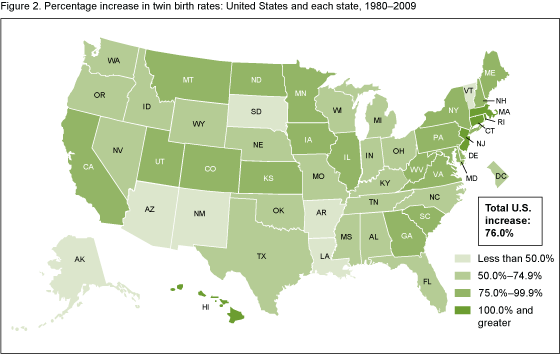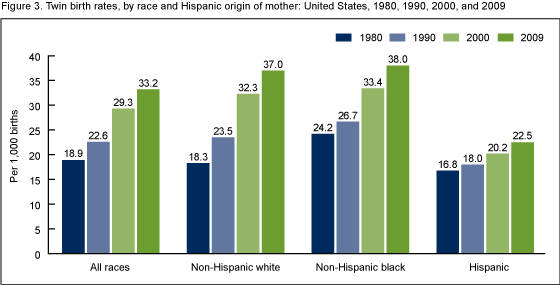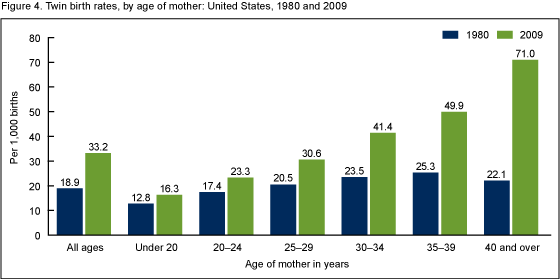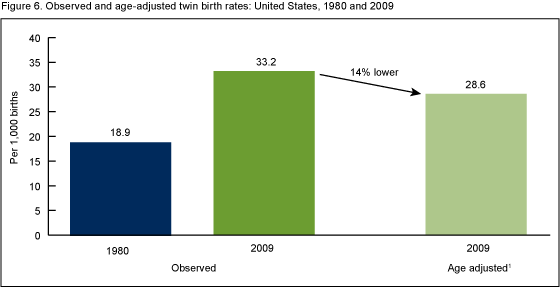Three Decades of Twin Births in the United States, 1980–2009
On This Page
- Key findings
- One in every 30 infants born in 2009 was a twin.
- Twin birth rates increased in all states from 1980 through 2009.
- Twin birth rates doubled among non-Hispanic white mothers over the three decades.
- Twinning rates rose by more than 200 percent among women aged 40 and over.
- The age distribution of women giving birth changed over the three decades.
- Older maternal age accounts for only about one-third of the rise in twinning over the 30 years.
- Summary
- Definitions
- Data sources and methods
- About the authors
- References
- Suggested citation
NCHS Data Brief No. 80, January 2012
PDF Version (619 KB)
Joyce A. Martin, M.P.H.; Brady E. Hamilton, Ph.D.; and Michelle J.K. Osterman, M.H.S.
Key findings
- In 2009, 1 in every 30 babies born in the United States was a twin, compared with 1 in every 53 babies in 1980.
- The twin birth rate rose 76 percent from 1980 through 2009, from 18.9 to 33.3 per 1,000 births.
- If the rate of twin births had not changed since 1980, approximately 865,000 fewer twins would have been born in the United States over the last three decades.
- Twinning rates rose by at least 50 percent in the vast majority of states and the District of Columbia.
- Over the three decades, twin birth rates rose by nearly 100 percent among women aged 35–39 and more than 200 percent among women aged 40 and over.
- The older age of women at childbirth in 2009 compared with three decades earlier accounts for only about one-third of the rise in twinning over the 30 years.
The incidence of multiple births in the United States was quite stable at about 2 percent of all births from 1915 (the earliest year for which reliable data are available) through the 1970s (1–3). By the early 1980s, however, twinning rates, and those for triplet and higher-order multiples (triplet/+) began to rise (3,4), ultimately leading to what has been called “an epidemic of multiple pregnancies” (5). The marked increase in multiple births is important for reasons beyond their relative rarity. Plural pregnancies tend to exact a greater toll on the health of the mother (6,7), and outcomes for births in multiple deliveries are often compromised compared with singletons (6,7). The rise in the rate of twins, which comprise the majority of multiples (96 percent in 2009), has had an unfavorable impact on key indicators of perinatal health such as rates of preterm birth and low birthweight (8). This report describes U.S. trends in births in twin deliveries for the 30-year period 1980–2009.
Keywords: National Vital Statistics System, race and Hispanic origin, state-specific rates
One in every 30 infants born in 2009 was a twin.
- The number of twin births more than doubled from 1980 through 2009, rising from 68,339 to more than 137,000 births in each year from 2006 to 2009. In 1980, 1 in every 53 babies born in the United States was a twin, compared with 1 in every 30 births in 2009 (Figure 1).
- Over the three decades, the twin birth rate rose by 76 percent, from 18.9 to 33.2 per 1,000 births (or from 1.9 percent to 3.3 percent of all births) (Figure 1).
- Increases in the twin birth rate averaged more than 2 percent a year from 1980 through 2004 (peaking at more than 4 percent from 1995 to 1998). From 2005 to 2009, however, the pace of increase slowed to less than 1 percent annually.
- If the rate of twin births had not changed from the 1980 level, approximately 865,000 fewer twins would have been born in the United States over the three decades.

SOURCE: CDC/NCHS, National Vital Statistics System.
Twin birth rates increased in all states from 1980 through 2009.
- Increases in twin birth rates are seen in all 50 states and the District of Columbia over the three decades. Rates rose by at least 50 percent in 43 states and the District of Columbia, and by more than 100 percent in five states (Connecticut, Hawaii, Massachusetts, New Jersey, and Rhode Island) (Figure 2).
- Twinning rates differed widely by state in 2009. Rates ranged from a low of 22.3 per 1,000 births in New Mexico (2 percent of births), to a high of 45.9 in Connecticut (nearly 5 percent of births).

NOTES: The change in the twin birth rate for New Mexico is based on data years 1982–2009.
Access data table for Figure 2 [PDF – 101 KB].
SOURCE: CDC/NCHS, National Vital Statistics System.
Twin birth rates doubled among non-Hispanic white mothers over the three decades.
- Twin birth rates rose among each of the three largest race and Hispanic origin groups from 1980 through 2009. Rates doubled among non-Hispanic white mothers, rose by about one-half among non-Hispanic black mothers, and by one-third among Hispanic mothers (Figure 3).
- Twinning rates historically have been higher among non-Hispanic black women (4). The difference has narrowed over the three decades, however, as twinning rates for non-Hispanic white mothers have risen at a greater pace. In 2009, the twinning rate for non-Hispanic black mothers (38.0 per 1,000) was only slightly higher than that for non-Hispanic white mothers (37.0).
- Hispanic mothers continue to be less likely to bear twins. In 2009, their rate (22.5 per 1,000) was about two-thirds that of non-Hispanic white and non-Hispanic black women.

NOTE: 1980 data by race and Hispanic origin are based on a 22-state reporting area representing approximately 90% of births for that year.
SOURCE: CDC/NCHS, National Vital Statistics System.
Twinning rates rose by more than 200 percent among women aged 40 and over.
- Twin birth rates increased for women of all ages over the three decades, with the largest increases among women aged 30 and over. From 1980 to 2009, rates increased 76 percent for women aged 30–34, nearly 100 percent for women aged 35–39, and more than 200 percent for women aged 40 and over (Figure 4).
- Historically, twin birth rates have risen with advancing age, peaking at 35–39 years and declining thereafter (4). Since 1997, however, rates have been highest among women in their 40s.
- In 2009, 7 percent of all births to women aged 40 and over were born in a twin delivery compared with 5 percent of births to women aged 35–39, and 2 percent of births to women under age 25.

SOURCE: CDC/NCHS, National Vital Statistics System.
The age distribution of women giving birth changed over the three decades.
- Over this 30-year period (1980–2009), the overall age distribution of women giving birth in the United States shifted—a result of delayed childbearing and an older female population. In 1980, women aged 30 and over accounted for about 20 percent of all births (i.e., singletons, twins, and higher-order multiples), compared with more than 35 percent for 2000–2009 (Figure 5).
- The increasingly older age of mothers over the decades would be expected to influence twin birth rates because of the higher spontaneous (i.e., without the use of fertility therapies) twinning rates of women in their 30s.

SOURCE: CDC/NCHS, National Vital Statistics System.
Older maternal age accounts for only about one-third of the rise in twinning over the 30 years.
- The older maternal age distribution explains only some of the increase in the twinning rate. If this distribution had not changed (that is, the age distribution of women giving birth in 2009 was similar to that in 1980), the twin birth rate would be only 14 percent lower (28.6 compared with 33.2 per 1,000); that is, older maternal age accounts for only part, or about one-third of the total rise in the twin birth rate over the study period (Figure 6).
- Another factor related to the rise in twinning in recent years is the increased use of infertility treatments, both assisted reproductive technologies (ART) (e.g., in vitro fertilization) and non-ART treatments (ovulation stimulation medications without ART) (9,10). The use of these therapies became more prevalent during the 1980s and 1990s and is more common among women aged 30 and over (11).
- Much of the rise in twinning over the three decades not accounted for by the older maternal age distribution, or about two-thirds of the increase in the twin birth rate from 1980 to 2009, is likely associated with these therapies (9,10).

1The 1980 U.S. maternal age distribution was used as the standard population.
SOURCE: CDC/NCHS, National Vital Statistics System.
Summary
The number of twins has doubled and the rate of twin births has risen by more than three-fourths over the three decades 1980–2009. Increases in twin birth rates averaged more than 2 percent annually from 1980 to 2004, but the pace of increase slowed to less than 1 percent from 2005 to 2009. The increase in twinning over the three decades has been widespread, occurring across age and race and Hispanic origin groups, and in all states within the United States. The largest increases have been among non-Hispanic white women and mothers aged 30 and over.
Older maternal age accounts for about one-third of the growth in the twinning rate over this period. The increased availability and use of infertility treatments likely explains much of the remainder of the rise (9,10). Similar increasing trends in multiple births associated with both maternal age and infertility therapies have been observed in Western Europe and other countries during the 1980s and 1990s (10,12).
The study of multiple births is important because of their elevated health risks and accompanying greater health care costs (6). The rise in twinning has influenced the upward trend in key infant health indicators such as preterm and low birthweight rates during the 1980s and 1990s (8). An estimated additional 865,000 twins were born in the United States over the study period due to rising rates; more than one-half of these infants were low birthweight, and 1 in 10 were very low birthweight (3,4,13). New information soon to be available from the 2003 revision of the U.S. Standard Certificate of Live Birth and the U.S. Standard Report of Fetal Death on topics such as use of infertility treatment and admission to a neonatal intensive care unit, will further expand understanding of the causes and risks of multiple-gestation pregnancies.
Definitions
Twin birth: Refers to individual live birth in a twin pregnancy; does not include births in triplet and higher order multiple-gestation pregnancies.
Twin birth rate: Refers to the number of twin births per 1,000 total births.
Data sources and methods
This report contains data from the Natality Data File from the National Vital Statistics System. The vital statistics natality file includes information on a wide range of maternal and infant demographic and health characteristics for all births occurring in the United States.
Direct standardization was used to estimate the effect of the changing maternal age distribution on twin birth rates over the study period. The 1980 distribution of births by age of mother is used as the standard population. The impact of the age adjustment on the relative change in the twin birth rate from 1980 to 2009 is calculated as the difference between the 2009 observed and age-adjusted rate twin birth rates over the difference between the 1980 and 2009 observed rates.
The additional number of twins born as the result of rising twin birth rates is calculated by applying the 1980 twin birth rate to the total number of births for each year during 1981–2009 and subtracting from the observed number of 2009 twin births.
Information on births of Hispanic origin for 1980 was available for a 22-state reporting area: Arizona, Arkansas, California, Colorado, Florida, Georgia, Hawaii, Illinois, Indiana, Kansas, Maine, Mississippi, Nebraska, Nevada, New Jersey, New Mexico, New York, North Dakota, Ohio, Texas, Utah, and Wyoming. These states accounted for 57 percent of all U.S. births in 1980, an estimated 57 percent of births to non-Hispanic white and non-Hispanic black mothers, and 90 percent of all births to Hispanic mothers. The twin birth rate for New Mexico is based on 1982 data; information by plurality for New Mexico was not reliable for 1980 and 1981.
About the authors
Joyce A. Martin, Brady E. Hamilton, and Michelle J.K. Osterman are with the Centers for Disease Control and Prevention’s National Center for Health Statistics, Division of Vital Statistics, Reproductive Statistics Branch.
References
- National Center for Health Statistics. Vital Statistics of the United States, 1917–1993.
- National Center for Health Statistics. Vital statistics rates in the United States, 1940–1960. Washington, DC: U.S. Department of Health, Education, and Welfare, Public Health Service. 1968.
- Taffel SM. Health and demographic characteristics of twin births: United States, 1988. National Center for Health Statistics. Vital Health Stat 21(50). 1992.
- Martin JA, Park MM. Trends in twin and triplet births: 1980–97. National vital statistics reports; vol 47 no 24. Hyattsville, MD: National Center for Health Statistics. 1999.
- Newman RB, Luke B. Multifetal pregnancy: A handbook for care of the pregnant patient. Philadelphia, PA: Lippincott William & Wilkins. 2000.
- The ESHRE Capri Workshop Group. Multiple gestation pregnancy. Hum Reprod 15(8):1856–64. 2000.
- Luke B, Brown MB. Contemporary risks of maternal morbidity and adverse outcomes with increasing maternal age and plurality. Fertil Steril 88(2):283–93. 2007.
- Blondel B, Kogan MD, Alexander GR, Dattani N, Kramer MS, Macfarlane A, Wen SW. The impact of the increasing number of multiple births on the rates of preterm birth and low birthweight: An international study. Am J Pub Health 92(8):1323–30. 2002.
- Reynolds MA, Schieve LA, Martin JA, Jeng G, Macaluso M. Trends in multiple births conceived using assisted reproductive technology, United States, 1997–2000. Pediatrics 111(5 Part 2):1159–66. 2003.
- Blondel B, Kaminski M. Trends in the occurrence, determinants, and consequences of multiple births. Semin Perinatol 26(4):239–49. 2002.
- Chandra A, Stephen EH. Infertility service use among U.S. women: 1995 and 2002. Fertil Steril 93(3):725–36. 2010.
- Imaizumi Y. Trends of twinning rates in ten countries, 1972–1996. Acta Genet Med Gemellol (Roma) 46(4):209–18. 1997.
- Martin JA, Hamilton BE, Ventura SJ, et al. Births: Final data for 2009. National vital statistics reports; vol 60 no 1. Hyattsville, MD: National Center for Health Statistics. 2011.
Suggested citation
Martin JA, Hamilton BE, Osterman MJK. Three decades of twin births in the United States, 1980–2009. NCHS data brief, no 80. Hyattsville, MD: National Center for Health Statistics. 2012.
Copyright information
All material appearing in this report is in the public domain and may be reproduced or copied without permission; citation as to source, however, is appreciated.
National Center for Health Statistics
Edward J. Sondik, Ph.D., Director
Jennifer H. Madans, Ph.D., Associate Director for Science
Division of Vital Statistics
Charles J. Rothwell, M.S., Director
- Page last reviewed: November 6, 2015
- Page last updated: January 4, 2012
- Content source:


 ShareCompartir
ShareCompartir